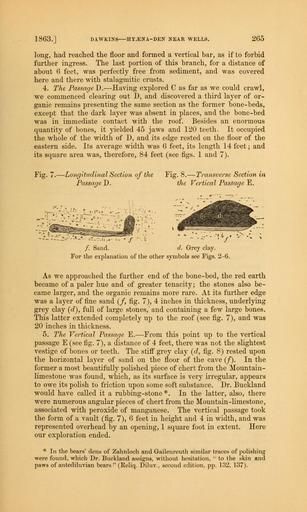MAKE A MEME
View Large Image

| View Original: | The_Quarterly_journal_of_the_Geological_Society_of_London_(12645765045).jpg (1225x2046) | |||
| Download: | Original | Medium | Small | Thumb |
| Courtesy of: | commons.wikimedia.org | More Like This | ||
| Keywords: The Quarterly journal of the Geological Society of London (12645765045).jpg 1863 <br> DAWKINS HY ENA-DEN NEAR WELLS <br> 265 <br> long had reached the floor and formed a vertical bar as if to forbid <br> further ingress The last portion of this branch for a distance of <br> about 6 feet was perfectly free from sediment and was covered <br> here and there with stalagmitic crusts <br> 4 The Passage D Having explored C as far as we could crawl <br> we commenced clearing out D and discovered a third layer of or- <br> ganic remains presenting the same section as the former bone -beds <br> except that the dark layer was absent in places and the bone-bed <br> was in immediate contact with the roof Besides an enormous <br> quantity of bones it yielded 45 jaws and 120 teeth It occupied <br> the whole of the width of D and its edge rested on the floor of the <br> eastern side Its average width w r as 6 feet its length 14 feet ; and <br> its square area was therefore 84 feet see figs 1 and 7 <br> Fig 7 Longitudinal Section of the Fig 8 Transverse Section in <br> Passage D the Vertical Passage E <br> / Sand d Grey clay <br> For the explanation of the other symbols see Figs 2-6 <br> As we approached the further end of the bone-bed the red earth <br> became of a paler hue and of greater tenacity; the stones also be- <br> came larger and the organic remains more rare At its further edge <br> was a layer of fine sand / fig 7 4 inches in thickness underlying <br> grey clay d full of large stones ' and containing a few large bones <br> This latter extended completely up to the roof see fig 7 and was <br> 20 inches in thickness <br> 5 The Vertical Passage E From this point up to the vertical <br> passage E see fig 7 a distance of 4 feet there was not the slightest <br> vestige of bones or teeth The stiff grey clay d fig 8 rested upon <br> the horizontal layer of sand on the floor of the cave f In the <br> former a most beautifully polished piece of chert from the Mountain- <br> limestone was found which as its surface is very irregular appears <br> to owe its polish to friction upon some soft substance Dr Buckland <br> would have called it a rubbing-stone In the latter also there <br> were numerous angular pieces of chert from the Mountain -limestone <br> associated with peroxide of manganese The vertical passage took <br> the form of a vault fig 7 6 feet in height and 4 in width and was <br> represented overhead by an opening 1 square foot in extent Here <br> our exploration ended <br> In the bears' dens of Zahnloch and G-ailenreuth similar traces of polishing <br> were found which Dr Buckland assigns without hesitation to the skin and <br> paws of antediluvian bears Reliq Diluv second edition pp 132 137 35328230 109632 51125 Page 265 Text v 19 http //www biodiversitylibrary org/page/35328230 1863 Geological Society of London Biodiversity Heritage Library The Quarterly journal of the Geological Society of London v 19 1863 Geology Periodicals Smithsonian Libraries bhl page 35328230 dc identifier http //biodiversitylibrary org/page/35328230 smithsonian libraries Information field Flickr posted date ISOdate 2014-02-20 Check categories 2015 August 26 CC-BY-2 0 BioDivLibrary https //flickr com/photos/61021753 N02/12645765045 2015-08-27 11 00 05 cc-by-2 0 PD-old-70-1923 The Quarterly journal of the Geological Society of London 1863 Photos uploaded from Flickr by FĂŚ using a script | ||||